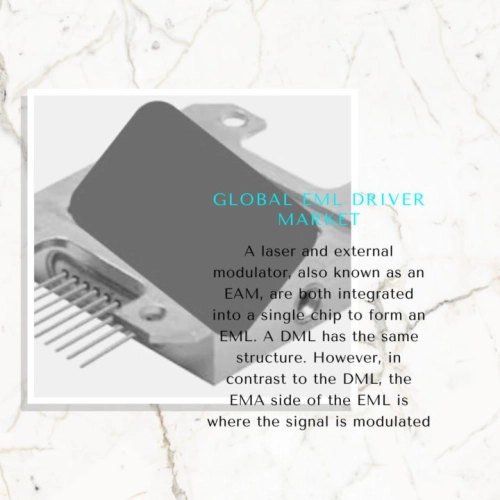
- Get in Touch with Us

Last Updated: Apr 25, 2025 | Study Period: 2022-2030
A laser and external modulator, also known as an EAM, are both integrated into a single chip to form an EML. A DML has the same structure. However, in contrast to the DML, the EMA side of the EML is where the signal is modulated, not the electrical side.

The Global EML Driver market accounted for $XX Billion in 2021 and is anticipated to reach $XX Billion by 2030, registering a CAGR of XX% from 2022 to 2030.
The HXT45110-4, an optical receiver transmitter array (ORTA) device from Renesas, is a single-channel linear EML driver die. In order to construct the next generation of 100G and 200G/400G optical small form factor (SFF) transceivers, a tiny linear transmitter can be combined with an EML.
For 112Gbps PAM4 EML-based transceivers, the device is a low-power, high-performance, single channel linear driver die with differential input and single-ended output that has one 56 Gbaud broadband amplifier channel.
Low power applications can benefit from its ability to provide a linear output voltage as low as 1.2Vpp thanks to this architecture.
For SFP+ 10GBase-ER/ZR Ethernet and 8.5Gb/s Fibre Channel applications, the GN1412 from Semtech is an integrated bi-directional EML laser driver and limiting amplifier. It is a highly integrated, low-power, and tiny-footprint device that works best with optical modules with compact form factors.
An EML laser driver and optional input equalisation make up the broadcast path. A limiting amplifier with programmable equalisation and an output driver with programmable swing make up the receive circuit.
An ideal electrical and optical output is made possible by the transmit direction's highly configurable eye shaping feature, which includes separately programmable rise and fall pre-emphasis. The options for output mute, loopback, and polarity-invert are available in both directions.
| Sl no | Topic |
| 1 | Market Segmentation |
| 2 | Scope of the report |
| 3 | Abbreviations |
| 4 | Research Methodology |
| 5 | Executive Summary |
| 6 | Introduction |
| 7 | Insights from Industry stakeholders |
| 8 | Cost breakdown of Product by sub-components and average profit margin |
| 9 | Disruptive innovation in the Industry |
| 10 | Technology trends in the Industry |
| 11 | Consumer trends in the industry |
| 12 | Recent Production Milestones |
| 13 | Component Manufacturing in US, EU and China |
| 14 | COVID-19 impact on overall market |
| 15 | COVID-19 impact on Production of components |
| 16 | COVID-19 impact on Point of sale |
| 17 | Market Segmentation, Dynamics and Forecast by Geography, 2022-2030 |
| 18 | Market Segmentation, Dynamics and Forecast by Product Type, 2022-2030 |
| 19 | Market Segmentation, Dynamics and Forecast by Application, 2022-2030 |
| 20 | Market Segmentation, Dynamics and Forecast by End use, 2022-2030 |
| 21 | Product installation rate by OEM, 2022 |
| 22 | Incline/Decline in Average B-2-B selling price in past 5 years |
| 23 | Competition from substitute products |
| 24 | Gross margin and average profitability of suppliers |
| 25 | New product development in past 12 months |
| 26 | M&A in past 12 months |
| 27 | Growth strategy of leading players |
| 28 | Market share of vendors, 2022 |
| 29 | Company Profiles |
| 30 | Unmet needs and opportunity for new suppliers |
| 31 | Conclusion |
| 32 | Appendix |